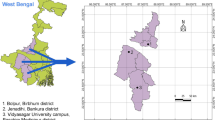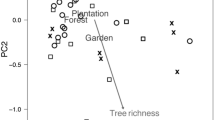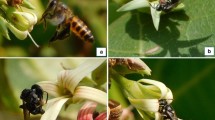Abstract
We present chemical analysis of four rotten or fungus-infected logs that attracted fragrance-collecting male euglossine bees. Eight of the 10 volatile compounds detected have never been found in the fragrances of orchids pollinated by male euglossine bees. Nonfloral sources of chemicals such as rotting wood may constitute an important fragrance resource for male bees. Since rotten logs produce large quantities of chemicals over long periods of time, such nonfloral sources might be more important than flowers as a source of certain fragrances for some euglossine bee species. Fragrance collecting in euglossine bees might have evolved originally in relation with rotting wood rather than flowers.
Similar content being viewed by others
References
Ackerman, J.D. 1983. Specificity and mutual dependency of the orchid-euglossine bee interaction.Biol. J. Linn. Soc. 20:301–314.
Ackerman, J.D. 1985. Euglossine bees and their nectar hosts, pp. 225–233,in W.G. D'Arcy and M.D. Correa (eds.). The Botany and Natural History of Panama. Missouri Botanical Garden, St. Louis, Missouri.
Ackerman, J.D. 1989. Geographic and seasonal variation in fragrance choices and preferences of male euglossine bees.Biotropica 21:340–347.
Ausloos, P., Clifton, C., Lias, S.G., Shamim, A., Stein, S.E. 1992. NIST/EPA/NIH Mass Spectral Database, PC Version 4.0. National Institute of Standards and Technology, Gaithersburg, Maryland.
Dodson, C.H. 1975. Coevolution of orchids and bees, pp. 91–99,in L.E. Gilbert and P.H. Raven (eds.). Coevolution of Animals and Plants. University of Texas Press, Austin, Texas.
Dressler, R.L. 1967. Why do euglossine bees visit orchid flowers?Atas Simpo. Sobre Biota Amazon. 5:171–180.
Dressler, R.L. 1982. Biology of the orchid bees (Euglossini).Annu. Rev. Ecol. Syst. 13:373–394.
Gerlach, G., andSchill, R. 1989. Fragrance analyses, an aid to taxonomic relationships of the genusCoryanthes (Orchidaceae).Plant Syst. Evol. 168:159–165.
Gerlach, G., andSchill, R. 1991. Composition of orchid scents attracting euglossine bees.Bot. Acta 104:379–391.
Janzen, D.H. 1971. Euglossine bees as long-distance pollinators of tropical plants.Science 171:203–205.
Janzen, D.H., De Vries, P.J., Higgins, M.L., andKimsey, L.S. 1981. Seasonal and site variation in Costa Rican euglossine bees at chemical baits in a deciduous forest and an evergreen forest.Ecology 63:66–74.
Kaiser, R. 1993. The Scent of Orchids: Olfactory and Chemical Investigations. Elsevier, Amsterdam. 259 pp.
Kiester, A.R., Lande, R., andSchemske, D.W. 1984. Models of coevolution and speciation in plants and their pollinators.Am. Nat. 124:220–243.
Kimsey, L.S. 1980. The behaviour of male orchid bees (Apidae, Hymenoptera, Insecta) and the question of leks.Anim. Behav. 28:996–1004.
Kimsey, L.S. 1982. Abstract. International Union for the Study of Social Insects Meetings at Boulder, Colorado.
Kimsey, L.S. 1984. The behavioral and structural aspects of grooming and related activities in euglossine bees (Hymenoptera: Apidae).J. Zool. 204:541–550.
Lunau, K. 1992. Evolutionary aspects of perfume collection in male euglossine bees (Hymenoptera) and of nest deception in bee-pollinated flowers.Chemoecology 3:65–73.
Roberts, D.R., Alecrim, W.D., Heller, J.M., Ehrhardt, S.R., andLima, J.B. 1982. MaleEufriesia purpurata, a DDT-collecting bee in Brazil.Nature 297:62–63.
Roubik, D.W. 1989. Ecology and Natural History of Tropical Bees. Cambridge University Press, Cambridge. 514 pp.
Roubik, D.W., andAckerman, J.D. 1987. Long-term ecology of euglossine orchid-bees (Apidae: Euglossini) in Panama.Oecologia 73:321–333.
Schemske, D.W., andLande, R. 1984. Fragrance collection and territorial display by male orchid bees.Anim. Behav. 32:935–937.
Smith, B.N., andMeeuse, B.J.D. 1966. Production of volatile amines and skatole at anthesis in someArum lily species.Plant Physiol. 41:343–347.
Stern, D.L. 1991. Male territoriality and alternative male behaviors in the euglossine beeEulaema meriana (Hymenoptera: Apidae).J. Kans. Entomol. Soc. 64:421–437.
Tabacchi, R., andNicollier, G. 1979. Contribution to the knowledge of the chemical composition of oak moss (Evernia prunastri Ach.).Int. Congr. Essent. Oils 7:394–387. Japan Flavor Fragrance Manuf. Assoc. Tokyo.
Whitten, W.M., Young, A.M., andWilliams, N.H. 1989. Function of glandular secretions in fragrance collection by male euglossine bees (Apidae: Euglossini).J. Chem. Ecol. 15:1285–1295.
Williams, N.H. 1982. The biology of orchids and euglossine bees. pp. 119–171in J. Arditti (ed.). Orchid Biology: Reviews and Perspectives, II. Cornell Univ. Press. Ithaca, New York.
Williams, N.H., andWhitten, W.M. 1983. Orchid floral fragrances and male euglossine bees: Methods and advances in the last sesquidecade.Biol. Bull. 164:355–395.
Author information
Authors and Affiliations
Rights and permissions
About this article
Cite this article
Whitten, W.M., Young, A.M. & Stern, D.L. Nonfloral sources of chemicals that attract male euglossine bees (Apidae: Euglossini). J Chem Ecol 19, 3017–3027 (1993). https://doi.org/10.1007/BF00980599
Received:
Accepted:
Issue Date:
DOI: https://doi.org/10.1007/BF00980599




